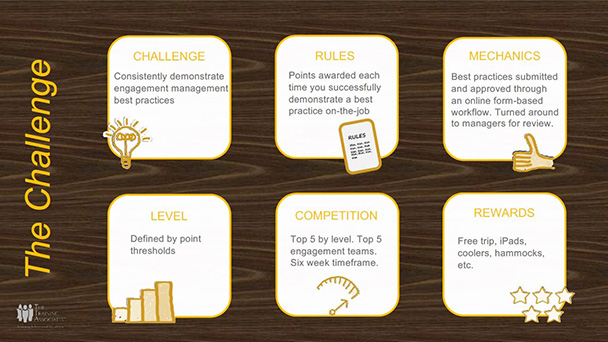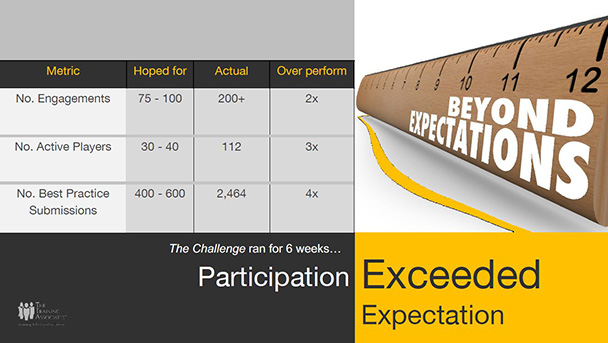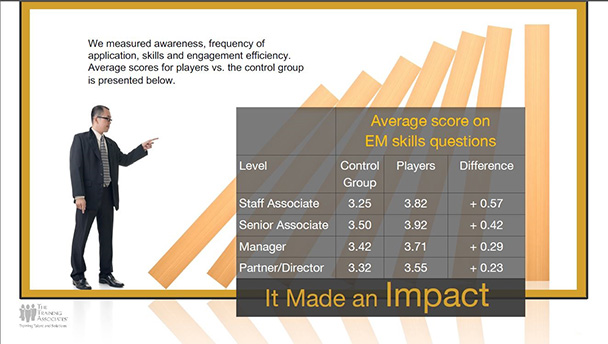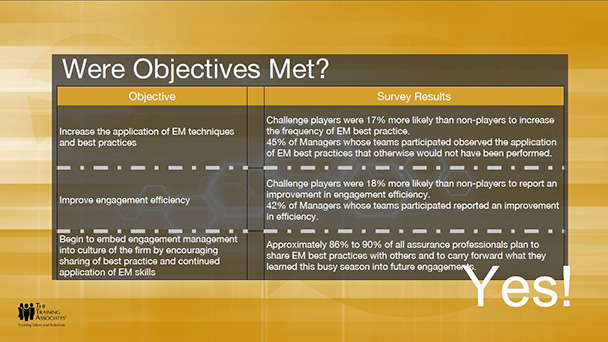Dixon Hughes Goodman, a large CPA firm, counted on gamification to improve the project management skills of its auditors. The Charlotte, North Carolina–based company has 34 offices, primarily in the Southeast, with revenue in excess of $330 million. The firm employs more than 1,200 professionals, approximately 500 of whom are in the firm’s audit services practice.
Business challenge
Inefficient service delivery is a common problem in the accounting industry. Dixon Hughes Goodman determined that a main culprit at the firm was its auditors’ poor project management skills. The firm turned to consultants Jerry Gschwind, Michael Ramos, and The Training Associates to deliver a solution that would sharpen the project management skills of its auditors and improve the overall profitability of the organization.
Solution design
The client initially requested a training class, but then wondered whether a classroom learning experience alone was really going to drive behavior and make a difference. “They realized they could do more. That’s how we got started with the gamification piece,” Ramos said.
Ramos and his team created The Challenge (Figure 1), which applied game-like elements to engagement management. Auditors could accumulate points by successfully completing best-practice actions.
“They [auditors] did their work, applying the engagement-management practices like they were supposed to do,” Gschwind said. “Throughout the process, they were encouraged to submit online forms describing the actions they took. Managers reviewed the forms, approving demonstrated best practices. Each best practice was worth a different number of points, depending on the difficulty. The points could later be exchanged for prizes.”

Figure 1: The Challenge encourages auditors to employ best practices of engagement management
The company launched its campaign in December 2015, beginning with a mandate for employees to participate in a series of webcasts detailing best practices of engagement management. More than 90 percent of the auditors complied. Participation in The Challenge, which ran for six weeks, was voluntary. At its conclusion, the consultants measured and compared active players to the control group of auditors who chose not to participate. They examined key metrics such as awareness of engagement-management skills, frequency of application, and engagement efficiency.
Results
A survey conducted immediately afterward showed that participation exceeded expectations in all categories, and that key corporate objectives were met (Figure 2). The Challenge drove awareness and application of project management best practices, and provided leadership with insight into how staff members manage audit engagements.
An engagement is defined as a project, and auditors typically work on several engagements concurrently. The company had hoped for 75 – 100 engagements during the six-week period; it actually tracked more than 200. The firm expected 30 – 40 employees to actively participate in The Challenge; 112 registered as active players, making at least one best-practice submission. And while the company was anticipating 400 – 600 best-practice submissions, it actually received 2,464—four times what it expected.

Figure 2: The Challenge exceeded expectations in all categories
Survey results found that Challenge players were 17 percent more likely than nonplayers to increase the frequency of engagement-management best practices, and 45 percent of managers whose teams participated observed the application of engagement-management best practices. Challenge players were 18 percent more likely to report an improvement in engagement efficiency, while 42 percent of managers whose teams participated reported an improvement in efficiency.
Participation
When submitting a best practice, employees were encouraged to share their actions with co-workers. If an auditor established a budget for an engagement (a company best practice), he or she could upload the document to serve as an example to others. Blog posts in the company newsletter celebrated Challenge activity.
Individual employees, teams, and offices competed against one another for points. Although the Asheville, North Carolina office is one of the smaller Dixon Hughes Goodman branches, it boasted a large number of participants and won the team challenge.
While Ramos and his team did not analyze results based on auditor demographics such as age or gender, data was separated by job title and position within the company. Categories included staff associate, senior associate, manager, and partner/director (Figure 3). All segments enthusiastically participated in The Challenge.
“What we discovered is that people across the board played, and that everyone who played benefited,” Gschwind said. “We got surprisingly good participation from the partners.”

Figure 3: Employees at every level in the company played and benefited

Figure 4: Company objectives were met
Key takeaways
In addition to meeting key objectives, operational insights gained by Dixon Hughes Goodman included the following:
- Most project management risks are related to client management issues
- Although staff understands the importance of project management skills, application of them is inconsistent across the firm
- There could be further improvement in the application of technology-enabled best practices
- The staff could benefit from additional training to help differentiate between technical audit risks and engagement-management risks
Want more?
Join us at FocusOn Learning 2017 Conference & Expo, June 20 – 22 in San Diego, California, for sessions with strategic and executive focus, such as How Gamification, Video, and Mobile Can Help Organizational Change: A Case Study.



